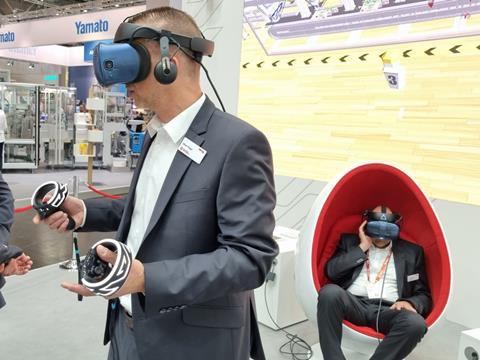
For US packaging machinery manufacturer Pearson Packaging Systems, digital twins are now an everyday support tool brought in, as it explains, to “boost our processes” and “kick our work up a level”. The company confirms it has succeeded in doing so by using the technology to facilitate a number of key performance and procedural improvements.
One is that it has enabled the company to carry out necessary pre-delivery work on the machines it is building, such as “running recipes” remotely in a virtual world and not, as was previously necessary, “on the shopfloor” – on the actual physical equipment, which has helped compress lead-times from order to delivery. A second is its use as a training tool to enable in-house engineers to swap from work on one product line to another. A third is its use to support problem-solving for equipment out in the field by enabling support staff to diagnose faults without having to travel to possibly distant locations where the equipment is actually running.
As such, Oliver Vogel, Team Leader and Solutions Consultant with a special focus on digital engineering and process automation with Rockwell Automation, says the use of digital twins by Pearson Packaging Systems perfectly illustrates the potential of the technology to generate real business benefits. The specific system used by Pearson Packaging Systems is also one with which he is entirely familiar because it is Rockwell Automation’s own Emulate3D software.
Vogel explains that digital twins mean the “representation in a digital environment of something physical”. In a manufacturing context that can, he says, “be a single machine or a whole plant.” Either way its starting point will be a 3D CAD model that records the actual geometry of the real-world entities involved.
But when that information is fed into the Emulate3D system, further essential attributes such as kinematics, the ability to replicate in the virtual world the movements of those real-world entities, can be added to enable the full potential of digital twins to be realised. “A digital twin has to be able to replicate actions,” confirms Vogel.
But a point of fundamental importance is that a digital twin can represent a real-world environment before that environment has been created. In short, it can be a planning tool as well as an operational support tool.
In that former use, says Vogel, immediate applications may involve ensuring the practicality of an intended factory layout by ensuring that the movement of equipment such as robot arms will not be potentially dangerous to people. Other uses might include identifying bottlenecks or calculating cycle times. “It is possible to see such things very early in a project,” he says.
In such contexts, Vogel says, direct visual analysis of the kinematic model of an intended installation will be necessary in order to identify potential hazards. “Those applications do need people to be involved,” he states.
But a digital twin can also model the control systems of an intended installation and in this case can provides a higher level of capability. As Vogel confirms: “Once the digital twin has been constructed it can automatically generate the controller code for the real installation.” Interestingly Vogel indicates that feedback from clients has indicated that they find the “debugging and virtual commissioning” of installations before they start real operations particularly useful.
Pearson Packaging Systems, for instance, reports that it can generate the code to drive robotic palletising operations much faster in the virtual world using Emulate3D, which would be possible by previous manual methods. Its engineers can then load the code into the machines with full confidence they will work as intended the first time. The company describes the capability as a “key metric” for judging the effectiveness of its use of the system.
The utility of a digital twin, though, continues into and indeed throughout the life of an installation once it is in operation. All of the capabilities that are evident before an installation is commissioned mean that, as Vogel points out, modifications can be planned and even trialled “while the as-built installation continues in real productive use.”
That is equally the case whether the machines involved are those that a company operates on its own shopfloor or whether they are ones that it has built for customers. Pearson Packaging Systems, for instance, reports that by creating digital twins of the machines it has already supplied it can use Emulate3D as a virtual troubleshooting tool to enable it to analyse and solve customer problems remotely and much more importantly speedily.
Meanwhile, Emulate3D also enables another US supplier of automated packaging equipment to provide an enhanced level of service to its customers. In this case, Wayne Automation Corporation reports that it uses the system to demonstrate to its customers and integration partners the feasibility of solutions very early in a project. It states that “validating the synthesis of mechanical design and controls testing in a fully digital environment” reduces both time and costs for its partners.
As Oliver Vogel concedes, these overall levels of capability are highly computing intensive. But that requirement is solved by the fact that Emulate3D utilises Cloud computing so that local processing power is “simply not a factor.”
As such, Vogel is confident that though appreciation of what the technology of digital twins can bring to manufacturing companies and perhaps particularly to machine builders is not yet pervasive it will continue to grow. “It is still an emerging technology and market,” he states. “But it will become increasingly relevant and will be a standard attribute for innovative companies.”










![IMG_0166[1]](https://d2wrwj382xgrci.cloudfront.net/Pictures/100x67/3/9/4/12394_img_01661_444145.jpg)
